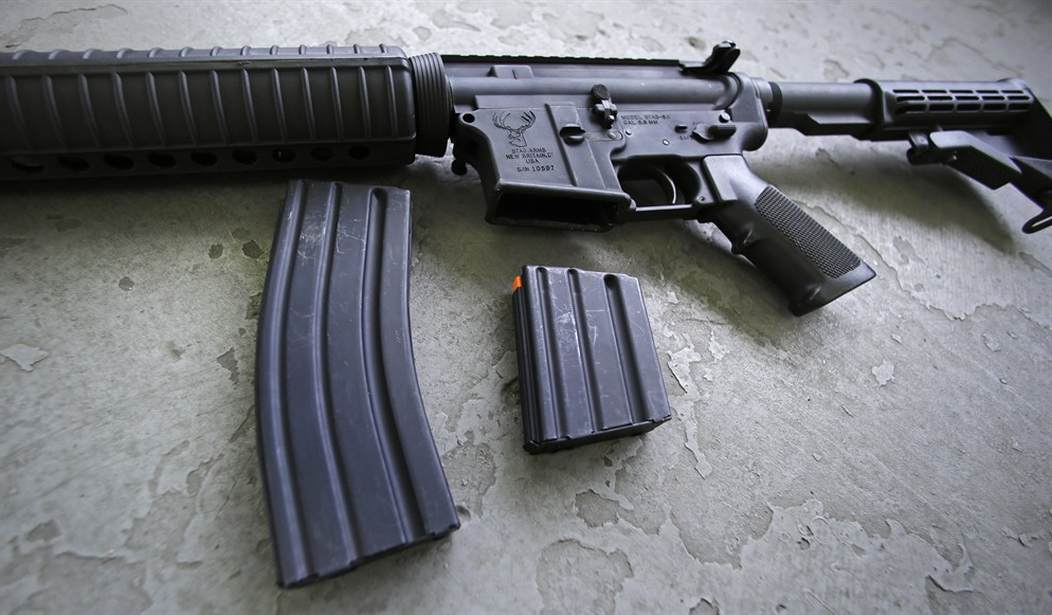Jazz Shaw, our friend over at our sister site Hot Air, wrote about a looming decision about Second Amendment rights from the Supreme Court that could come as early as this Tuesday. It deals with the Chicago-area city of Highland Park's ordinance that bans semi-automatic rifles that carry more than 10 rounds (via LA Times):
The justices on Friday were to consider the appeal in Friedman vs. City of Highland Park. If they refuse to hear the appeal, the announcement could come as early as Tuesday morning. Such a decision would signal that cities have the authority to restrict high-powered weapons.But if the justices vote to take up the case, it would put in doubt the constitutionality of laws in other places, including California, that prohibit semiautomatic weapons.
"These are some of the most popular firearms commonly used by law-abiding citizens in America," said David H. Thompson, a lawyer for the Illinois gun owners who are challenging the assault weapons ban adopted in the North Shore Chicago suburb of Highland Park.
They lost before a federal judge and in a decision from the 7th Circuit Court of Appeals in Chicago. Now they are asking the high court to hear their appeal.
[…]
In upholding the Highland Park ordinance, the 7th Circuit cited the Supreme Court's statement that "dangerous and unusual weapons" may be restricted.
"Assault weapons with large-capacity magazines can fire more shots, faster, and thus can be more dangerous in aggregate," said Judge Frank Easterbrook in April for a 2-1 majority. "Why else are they the weapons of choice in mass shootings? A ban on assault weapons and large-capacity magazines might not prevent shootings...but it may reduce the carnage if a mass shooting occurs."
In dissent, Judge Daniel Manion said some homeowners want to keep a semi-automatic weapon at home for self-defense. "Ultimately, it is up to the lawful gun owner and not the government to decide these matters," he wrote.
Recommended
Well, for starters, members of the media need to learn the difference between semi-automatic and automatic weapons. Simply put, a semiautomatic (or self-reloading) weapons system fires one round per trigger pull. Automatic fires multiple rounds per trigger pull. In fact, it’ll keep firing as long as that trigger is pulled back. They’re legal to own, though you’ll need to go through the ATF regarding the permit process.
There is no ban on semiautomatic weapons in the United States, as that which would mean a very extensive gun ban was passed in Congress without anyone knowing about it. California, and other blue states’ so-called assault weapons ban, prohibits the sale of semiautomatic AR-15-style rifles that hold more than 30 rounds. That’s not the same thing, as buying handguns, which are also semiautomatic, is still legal, though the process for that is highly cumbersome in these anti-gun states.
Second, and more to the point, it’s dubious whether the Supreme Court will hear arguments for this case. The Court has refused to hear a string of pro-Second Amendment cases, mostly relating to the concealed carry processes in “may issue” states. In 2013, Wollard v. Gallagher was asking the Court to address “whether state officials violated the Second Amendment by requiring that individuals wishing to exercise their right to carry a handgun for self-defense first prove a “good and substantial reason” for doing so.” The Court refused. In 2014, the Court refused to hear a New Jersey-based Second Amendment case–Drake v. Jerejian–which also asked “(1) Whether the Second Amendment secures a right to carry handguns outside the home for self-defense; and (2) whether state officials violate the Second Amendment by requiring that individuals wishing to exercise their right to carry a handgun for self-defense first prove a ‘justifiable need’ for doing so.”
The Drake case is especially tough to tolerate since it could have cleared a path to 50-state concealed carry rights given the first question. I’m sure it will be addressed in time. These cases spoke much more to the Second Amendment, and could have had a huge impact regarding expanding those rights, but the Court decided to take a pass…twice. The case we’re dealing with here is a city ordinance in one of the most anti-gun urban areas in the country. Don’t be shocked if they take a pass on this one too.
At the same time, Jazz noted something in his post that yet again places the anti-gun wing of America in a bind.
“Are you hoping for a ban on “high-powered weapons” or are you looking to get rid of automatic weapons?” Jazz asks. He aptly notes that hunting rifles are by far much more powerful than a AR-15 concerning the type of ammunition each weapon system carries, so a so-called “high-powered” weapons ban would undercut what gun control activists have been saying for years; that they support the rights of hunters but want to keep the more scary, yet less powerful, weapons out of civilian hands. They lost that battle too. Regarding automatic weapons, they’re already regulated by the ATF, with a process that takes anywhere from eight months to a year, possibly more. If approved, that weapons system goes into a federal database, and every additional feature or improvement to that weapons must first be cleared by the ATF. Sounds like banning isn’t necessary in this front either.
We should be taking a victory lap. Yes, public opinion can change, but it’s unlikely. We have won on every single front in this battle. We’ve won in Congress, the courts, the various legislatures, the ballot boxes, and the data and the polls show us–the pro-Second Amendment wing of America–stronger than ever. Then again, this seems to have been a double-edged sword, especially in the courts since a resemblance of a consensus has been formed on this issue. The courts aren’t really divided; even California’s Appeals Circuit struck down portions of the Golden State’s carry laws. The Supremes probably don’t see a need to move any faster on this issue. That doesn’t mean we stop fighting protecting our constitutional rights however.

























Join the conversation as a VIP Member